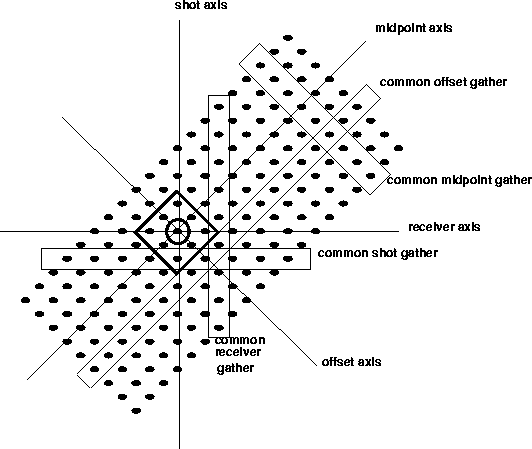




Next: Extensions for earthquake seismology
Up: Extensions
Previous: Two-dimensional extensions
So far,
I have only discussed predictions done within a single shot gather.
Applying the same process demonstrated previously to other gather types,
especially common-midpoint gathers and common-receiver gathers,
would be easy and would also allow bad shots to be deleted.
With only slight modifications,
these techniques can be extended to multiple dimensions.
Consider, for example, the gathers in Figure ![[*]](http://sepwww.stanford.edu/latex2html/cross_ref_motif.gif) .
The circled trace may be predicted from nearby traces in the shot,
receiver, or midpoint gathers,
but there is no reason that all the traces in the box around the circled
trace cannot be used to predict that trace.
This box may also be expanded to include as many traces as are needed.
.
The circled trace may be predicted from nearby traces in the shot,
receiver, or midpoint gathers,
but there is no reason that all the traces in the box around the circled
trace cannot be used to predict that trace.
This box may also be expanded to include as many traces as are needed.
gathers
Figure 9
Various gathers used in two-dimensional seismic data.

For three-dimensional acquisition,
the predictions done from the nearby traces shown in
Figure ![[*]](http://sepwww.stanford.edu/latex2html/cross_ref_motif.gif) can be extended to include traces in nearby
crosslines.
Eventually, all traces within a given distance of a point can
be used to predict a trace at that point.
can be extended to include traces in nearby
crosslines.
Eventually, all traces within a given distance of a point can
be used to predict a trace at that point.
The multiple dimensions available in prestack data allows other
uses for these ideas.
For example, the cable noise example discussed in
Larner et al., 1983
shows the noise
is unpredictable in CMP gathers, but is predictable in
shot or receiver gathers.
The unpredictability in the CMP gathers would allow the
trace-to-trace predictions done
there to remove this noise.
A similar case would be cable noise such as that of crab pots
caught in a marine cable.
Such noise may be predictable over several traces in a given
shot gather,
since each hydrophone is being excited with the same noise source.
Predictions in CMP gathers or receiver gathers
would not see this noise as predictable.
Bad or weak shots would also be unpredictable
in both the CMP gathers and in the receiver gathers.
Noise at a particular receiver position would also often
be unpredictable in both the CMP gathers and in the shot gathers.
So far the extensions to multiple dimensions only involve multiple
comparisons using two traces.
This could be considered as two-dimensional prediction done
in multiple directions.
These predictions could also be extended to multiple traces within
the two-dimensional predictions or be extended to multiple traces
in multiple dimensions.
This predictions could be seen as generalizing
Claerbout's steep-dip deconvolutionClaerbout (1993)
to allow lateral predictions.
These multiple-dimensional predictions could be used in two manners.
The first is to calculate a separate filter for every trace to be predicted.
The second is to calculate one filter for all traces in a window,
then predicting each traces from its neighbors with the filter.
The first option is considerably more expensive than the second,
since in the first case, one filter is calculated for every trace,
while in the second case, a single filter is calculated for all the traces.
The first option
relaxes the assumptions of stationarity somewhat,
since the filter can change from trace to trace,
but the second option is likely to characterize the signal better
because more traces go into the filter calculation.
As in the two-dimensional case,
it is not clear what advantages a single prediction
with a multiple-dimensional filter has over multiple
predictions with the simple two-trace filters.
Nevertheless, using a single multi-dimensional filter may allow
the prediction of low-amplitude noises since the filter constrains
the signal better than the many two-dimensional filters.





Next: Extensions for earthquake seismology
Up: Extensions
Previous: Two-dimensional extensions
Stanford Exploration Project
2/9/2001
![[*]](http://sepwww.stanford.edu/latex2html/cross_ref_motif.gif) .
The circled trace may be predicted from nearby traces in the shot,
receiver, or midpoint gathers,
but there is no reason that all the traces in the box around the circled
trace cannot be used to predict that trace.
This box may also be expanded to include as many traces as are needed.
.
The circled trace may be predicted from nearby traces in the shot,
receiver, or midpoint gathers,
but there is no reason that all the traces in the box around the circled
trace cannot be used to predict that trace.
This box may also be expanded to include as many traces as are needed.
